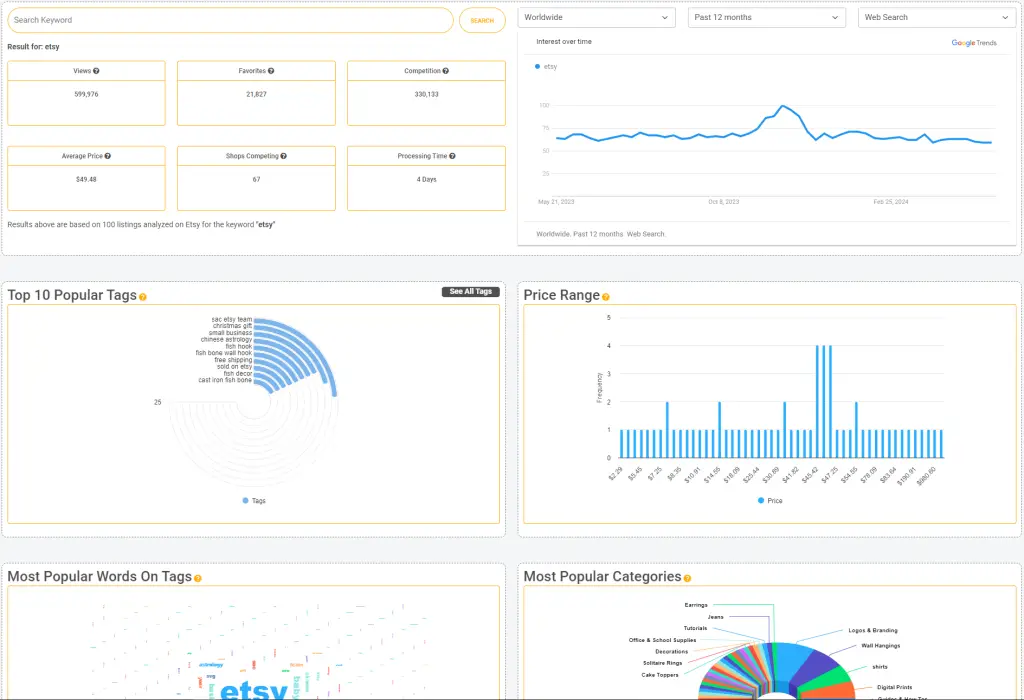Imagine pouring your heart and soul into crafting beautiful, unique products, only to have them languish unnoticed in the vast digital marketplace of Etsy. It’s a frustrating scenario many sellers face, but the good news is there’s a powerful tool at your disposal: Etsy SEO.
Etsy SEO, or search engine optimization, is the art and science of making your shop and listings more visible to shoppers searching for products like yours. Think of it as a roadmap guiding customers directly to your virtual doorstep. Done right, it can drastically increase your shop’s traffic, sales, and ultimately, your success on Etsy.
But here’s the catch: Etsy SEO isn’t a one-time task you can check off your list and forget. It’s an ongoing process of research, optimization, and adaptation. The Etsy algorithm, like the tastes of your target audience, is constantly evolving. Those who succeed commit to staying ahead of the curve, continually refining their strategies to align with the latest trends.
This comprehensive guide will equip you with everything you need to master Etsy SEO in 2024 and beyond. We’ll demystify the algorithm, explore effective keyword research strategies, and reveal step-by-step techniques for crafting irresistible titles, tags, and descriptions. Get ready to unlock your Etsy shop’s full potential!
Table of Contents:
- I. Introduction: Why Etsy SEO Matters
- II. Understanding the Etsy Search Algorithm
- III. Keyword Research: The Foundation of Etsy SEO
- IV. Crafting Killer Etsy Titles & Tags
- V. Optimizing Other Listing Elements
- VI. Optimizing Your Etsy Shop
- VII. Tracking Your Progress & Adapting Your Strategy
- VIII. Building a Loyal Customer Base for Better SEO
- IX. FAQ Section
- X. Conclusion: The Path to Etsy Success
I. Introduction: Why Etsy SEO Matters
With over 96 million active buyers, Etsy presents an incredible opportunity for creative entrepreneurs to reach a global audience. But standing out amidst millions of other listings is no easy feat. That’s where Etsy SEO comes in.
Think of Etsy SEO as your secret weapon for attracting the right customers to your shop. Instead of relying solely on chance encounters, effective SEO ensures your products appear prominently in search results when potential buyers are actively looking for items like yours.
Dispelling Common SEO Myths:
Many sellers mistakenly believe that simply “doing Etsy SEO” guarantees a flood of sales. However, as we’ll explore throughout this guide, SEO is a continuous journey of testing, learning, and adapting. There’s no magic formula or one-time fix.
![A frustrated Etsy seller looking at their computer with no sales.]
Image Description: A person sitting at their computer looking disappointed with no sales on their Etsy shop dashboard.](https://www.topbubbleindex.com/blog/wp-content/uploads/2024/05/Designer-76.jpeg)
II. Understanding the Etsy Search Algorithm
Before we dive into the nitty-gritty of optimization, let’s take a closer look at the driving force behind Etsy search: the algorithm. Like all search engines, Etsy’s algorithm aims to deliver the most relevant results to users based on their search queries. However, it differs from general search engines like Google in a few crucial ways:
- Emphasis on Products: While Google prioritizes informative content, Etsy’s algorithm is laser-focused on connecting buyers with relevant products.
- Multiple Algorithms: Etsy utilizes a combination of algorithms to determine search ranking, considering various factors beyond just keywords.
Key Ranking Factors:
- Relevancy: This is the foundation of Etsy SEO. Your listing’s titles, tags, attributes, and descriptions should directly and accurately reflect what users are searching for.
- Listing Quality Score: This metric gauges how well your listings perform in search. The more clicks, favorites, and purchases your listings receive, the higher your quality score, signaling to Etsy that your products are relevant and desirable.
- Customer & Marketplace Experience: Etsy wants to ensure buyers have a positive experience. Factors like positive reviews, complete shop policies, prompt customer service, and adherence to Etsy’s policies all contribute to a strong customer experience score.
- Recency: New listings get a temporary boost in search to help Etsy gather data on how shoppers interact with them. This means regular renewal of listings can be beneficial, especially for competitive niches.
- Shipping Price: Competitive shipping costs, ideally offering free shipping, can give your listings a significant edge in search results, particularly for US-based shops.
- Personalized Search: Etsy tailors search results based on individual user preferences, including their browsing history and past purchases. This means that not every shopper will see the same results for the same search query.
- Shop Location: For buyers in certain countries, like the UK and Australia, Etsy factors in the seller’s location. These shoppers often prefer to purchase from local sellers for faster shipping and lower costs.
- Shop Diversity: Etsy aims to showcase a variety of shops in its search results. This encourages shoppers to explore a wider range of products and sellers, enriching the overall marketplace experience.

III. Keyword Research: The Foundation of Etsy SEO
Now that we have a clearer understanding of how Etsy’s algorithm operates, let’s dive into the core of effective SEO: keyword research.
Think of keywords as the bridge connecting your products with eager buyers. The right keywords ensure your listings appear in search results when potential customers are actively looking for items like yours.
Types of Keywords:
- Long-tail keywords: These are phrases containing two or more words, offering a more specific and detailed description of your product. Long-tail keywords are often less competitive, making it easier for your listings to rank higher.
- Example: “Personalized leather dog collar” instead of just “dog collar.”
- Single keywords: These are broad, general terms with high competition, making it challenging to stand out in search results.
- Example: “Jewelry” or “Candles.”
Keyword Research Strategies:
- Brainstorming: Begin by putting yourself in the shoes of your ideal customer. What words would they use to search for products like yours? Consider:
- Unique features: What sets your product apart?
- Synonyms: Are there alternative words for your product? (e.g., “pillow” vs. “cushion”).
- Materials: What is your product made of? (e.g., “silver ring,” “oak table”).
- Style: What style describes your product? (e.g., “boho dress,” “minimalist art”).
- Intended use: How will customers use your product? (e.g., “wedding gift,” “travel mug”).
- Etsy Search Bar: The Etsy search bar is a valuable resource for uncovering popular keywords.
- Autocomplete suggestions: Start typing in a relevant term, and Etsy will suggest common search phrases based on user data.
- Explore related searches: Scroll to the bottom of a search results page, and you’ll find a section titled “Explore related searches.” This reveals terms shoppers frequently use in conjunction with your initial search.
- Google Search & Trends:
- Google Search: Use Google search to gauge keyword popularity and see what kind of results appear for your chosen terms.
- Google Trends: This tool provides insights into keyword search volume over time, helping you identify seasonal trends and rising keyword popularity.
- Competitor Analysis:
- Analyze the titles, tags, and descriptions of successful Etsy sellers in your niche. What keywords are they using? What seems to be working for them?
- Keyword Research Tools:
- Topbubbleindex: These Print-on-demand specific tools provide in-depth keyword analysis, including search volume, competition, and estimated click-through rates.
- Topbubbleindex etsy keyword research: This tool offers a particularly user-friendly interface and allows you to create keyword lists, track their performance over time, and even analyze your competitors’ keyword strategies.
- Topbubbleindex: These Print-on-demand specific tools provide in-depth keyword analysis, including search volume, competition, and estimated click-through rates.

IV. Crafting Killer Etsy Titles & Tags
With your keyword research arsenal fully loaded, it’s time to put those hard-earned insights to work! This section will focus on optimizing the two most impactful elements of your Etsy SEO: titles and tags.
Titles (Max 140 characters):
Think of your title as the first impression you make on potential customers. It needs to be concise, clear, and instantly communicate what your product is. Here’s how to craft Etsy titles that grab attention and boost your ranking:
- Lead with Your Superstar Keyword: Start your title with your most relevant and specific long-tail keyword. This instantly tells shoppers what your product is and strengthens your relevancy for that specific search query.
- Example: If your superstar keyword is “Handmade ceramic coffee mug,” make sure it appears at the beginning of your title.
- Avoid Keyword Stuffing: While it’s tempting to cram as many keywords into your title as possible, resist the urge to sacrifice readability for the sake of SEO. Unnatural and repetitive titles can actually harm your ranking and turn off potential buyers.
- Example: Instead of “Handmade Ceramic Coffee Mug, Coffee Mug Gift, Cute Coffee Mug,” opt for a more natural flow like “Handmade Ceramic Coffee Mug – Unique Gift for Coffee Lovers.”
- Write Unique Titles for Each Listing: Etsy’s algorithm values originality. Avoid using the same generic title across multiple listings, even if the products are similar. Take the time to craft unique titles that accurately reflect the individual characteristics of each item.
- Consider Google SEO: Etsy also promotes listings through offsite ads, meaning your titles and descriptions can appear in Google search results. Keep this in mind when crafting your titles, aiming for clarity and appeal to a broader audience beyond just Etsy users.

Tags (13 per listing, max 20 characters each):
Tags act as powerful signposts guiding shoppers to your listings. They allow you to target a wider range of search terms and increase your chances of appearing in relevant search results.
Here’s how to make the most of your 13 tags:
- Use All 13 Tags: Maximize your keyword reach by utilizing all available tag slots. This significantly increases the number of search queries your listing can potentially match.
- Prioritize Long-Tail Keywords: Just like in your title, focus on using long-tail keywords and multi-word phrases in your tags. They’re more descriptive, less competitive, and better reflect how shoppers actually search on Etsy.
- Avoid Repetition: Don’t waste valuable tag space by repeating keywords from your title, categories, or attributes. Etsy’s algorithm already takes these into account, so focus on introducing new, relevant terms.
- Target Specific Locations: If you’re targeting customers in a specific region or country, consider using regional phrases in your tags.
- Example: Use “football gift” for UK shoppers and “soccer gift” for US shoppers.
- Utilize Two-Word Tags: To make the most of your character limit, combine two relevant keywords into a single tag.
- Example: Instead of “vintage” and “mom mug” separately, use “vintage mom mug” as a single tag.
V. Optimizing Other Listing Elements
While titles and tags play a crucial role in Etsy SEO, optimizing other listing elements can further enhance your visibility and improve the customer experience.
Categories:
- Choose the Most Specific Category: Etsy’s extensive category system acts like keywords, helping shoppers find exactly what they’re looking for. Select the most precise category for your listing to ensure it appears in the most relevant search results.
- Use Tags to Specify Attributes: If your product doesn’t fit neatly into a specific category, don’t worry! Choose a more general category and utilize tags to highlight its unique attributes.
- Example: If you’re selling a handmade phone case with a specific design, you might categorize it under “Accessories” and then use tags like “floral phone case,” “iPhone 13 case,” or “personalized phone case.”
Attributes:
- Fill Out All Relevant Attributes: Attributes act as additional keywords and filter options, helping shoppers refine their search results. Etsy provides a list of predefined attributes for each category, so make sure to fill out all applicable options for your product. This includes details like size, color, material, occasion, intended recipient, and any unique features.
Descriptions:
- Craft a Keyword-Rich Meta Description: The first paragraph of your description serves as the meta description for Google SEO. This snippet of text appears under your listing’s title in Google search results, enticing shoppers to click through to your Etsy page. Craft a concise, keyword-rich description that accurately reflects your product and encourages clicks.
- Incorporate Keywords Naturally: Sprinkle a few of your chosen keywords naturally throughout your description. This further reinforces your listing’s relevancy for those search terms.
- Focus on Providing Value: While keywords are important, don’t forget that your description is ultimately aimed at human readers. Provide detailed and engaging information about your product, highlighting its benefits, features, and what makes it special. Avoid keyword stuffing and maintain a clear, conversational tone that resonates with your target audience.
Images & Videos:
- Feature Your Best Image First: The first image is the most important one, as it’s the first thing shoppers see in search results and on your listing page. Make sure it’s high-quality, well-lit, and accurately represents your product.
- Utilize All Image Slots: Etsy provides 10 image slots per listing – take advantage of them! Showcase your product from different angles, highlight specific details, and demonstrate its use or functionality.
- Consider Adding a Video: Videos offer an even more engaging way to showcase your product. Etsy allows videos up to 100MB, giving you ample opportunity to demonstrate your product’s features, benefits, and craftsmanship.

VI. Optimizing Your Etsy Shop
While individual listing optimization is crucial, don’t neglect your overall Etsy shop! A well-optimized shop further strengthens your SEO, builds brand identity, and provides a more welcoming experience for customers.
Shop Announcement:
- Your Elevator Pitch: Think of your shop announcement as your elevator pitch – a concise, compelling summary of your brand and products. Use this space to incorporate relevant keywords, highlight your unique selling proposition, and inform customers about any current promotions, shipping updates, or important announcements.
- Keep it Short and Sweet: Etsy recommends keeping announcements brief and to the point. Aim for a few sentences that capture the essence of your shop and encourage shoppers to browse your listings.
Shop Title:
- Maintain Consistency: For a cohesive brand experience, use your elevator pitch as your shop title. This reinforces your brand messaging and ensures consistency across your Etsy presence.
Shop Sections:
- Keyword-Rich Section Names: Organize your listings into clear, well-defined sections with names that incorporate relevant long-tail keywords. This makes it easier for shoppers to navigate your shop and find exactly what they’re looking for.
Shop Story:
- Connect with Customers: Your shop story is an opportunity to go beyond just selling products and connect with customers on a personal level. Share your brand’s origin story, your passion for your craft, and what makes your products special.
- Incorporate Keywords Naturally: Weave relevant keywords throughout your story, but avoid forcing them in unnaturally. Etsy’s algorithm can detect keyword stuffing, so focus on crafting a genuine and engaging narrative that resonates with your target audience.
- Showcase Your Best Work: Include high-quality images and even videos in your shop story to visually engage shoppers and highlight the craftsmanship of your products.
VII. Tracking Your Progress & Adapting Your Strategy
Etsy SEO isn’t a “set it and forget it” endeavor. It requires continuous monitoring and adjustments to stay ahead of the ever-evolving algorithm and changing shopper trends. This section will explore essential tools and strategies for tracking your SEO progress and adapting your approach for optimal results.
Etsy’s Built-in Analytics Tools:
Etsy provides two native analytics tools to help you track your shop’s performance:
- Etsy Search Analytics: Found in the “Marketing” section of your Shop Manager, this tool provides data on the keywords driving traffic to your listings, their click-through rates, and conversion rates. It allows you to see which keywords are performing well and identify opportunities for improvement.
- Etsy Stats: Located in the main menu of your Shop Manager, Etsy Stats (also known as Store Statistics) provides a comprehensive overview of your shop’s performance, including traffic sources, sales conversions, and ad performance. Use this tool to understand where your traffic is coming from, how shoppers are interacting with your listings, and which marketing strategies are yielding the best results.

VIII. Building a Loyal Customer Base for Better SEO
While it might seem counterintuitive, building a loyal customer base can significantly impact your Etsy SEO. Etsy’s algorithm favors shops with repeat customers, as it signals that your products are high-quality and provide a positive customer experience.
Strategies for Fostering Customer Loyalty:
- Prioritize Excellent Customer Service: Respond to customer inquiries promptly and professionally, addressing any concerns or questions with patience and empathy.
- Engage on Social Media: Utilize social media platforms like Instagram, Facebook, and Pinterest to connect with your audience on a personal level. Share behind-the-scenes content, run polls and contests, and actively participate in relevant online communities to build relationships with potential customers.
- Offer Discounts and Incentives: Reward repeat customers with exclusive discounts, coupons, or early access to new products. This encourages them to return to your shop and shows them you appreciate their loyalty.
- Add Personalized Touches: Include handwritten thank you notes, small gifts, or custom packaging to make your customers feel valued and appreciated.
- Maintain Ethical Business Practices: Operate your shop with integrity and transparency. Avoid copyright infringement, accurately represent your products, and strive to exceed customer expectations. Building trust and a positive reputation will go a long way in attracting loyal customers.

IX. FAQ Section
Etsy SEO can feel overwhelming, especially for new sellers navigating the platform’s intricacies for the first time. This section addresses some common questions and concerns to help you gain further clarity and confidence in your optimization journey.
Q: How do I find the best long-tail keywords for my listings?
A: Discovering effective long-tail keywords requires a combination of creative brainstorming and data-driven research.
- Start with Brainstorming: Put yourself in the shoes of your ideal customer. What specific phrases would they use to find your product? Consider its unique features, materials, style, and intended use.
- Leverage Etsy Search: Use Etsy’s search bar suggestions and the “Explore related searches” section to uncover popular terms and phrases related to your products.
- Analyze Your Competitors: Examine listings of successful shops in your niche. What long-tail keywords are they using? What seems to be working for them?
- Utilize Keyword Research Tools: Tools like Topbubbleindex’s Etsy Keyword Research offer in-depth analysis, providing data on search volume, competition, and estimated click-through rates for specific keywords. This allows you to identify promising long-tail keywords with high potential for ranking.
Q: Should I stuff my titles and descriptions with as many keywords as possible?
A: Definitely not! While it’s tempting to cram in every relevant keyword, this approach can backfire.
- Readability Matters: Keyword stuffing makes your titles and descriptions difficult to read and understand, turning off potential buyers.
- Etsy’s Algorithm Is Smart: Etsy can detect keyword stuffing and penalize listings that appear unnatural and spammy.
- Focus on Natural Language: Use keywords strategically and organically throughout your listings. Aim for a conversational tone that resonates with human readers while still incorporating relevant search terms.
Q: How often should I renew my listings?
A: The optimal renewal frequency depends on your niche and the level of competition you face.
- General Recommendation: Renewing listings every 2-7 days is a good starting point. This keeps your listings fresh in search results and reminds Etsy that your products are active.
- Renew After Changes: Always renew a listing immediately after making changes to its title, tags, or other key elements. This signals to Etsy to re-evaluate your listing and its relevancy.
- Experiment and Track Results: Use Etsy’s analytics tools to monitor how different renewal frequencies affect your listing’s performance. Adjust your strategy accordingly based on the data you gather.
Q: How can I accurately track my Etsy SEO performance?
A: Several tools provide valuable insights into your SEO performance, allowing you to identify successes and areas for improvement.
- Etsy Search Analytics: This built-in tool (free for all sellers) provides data on the keywords driving traffic to your listings, their click-through rates, and conversion rates.
- Etsy Stats: This comprehensive dashboard (free for all sellers) displays data on your shop’s overall performance, including traffic sources, sales, and ad effectiveness.
Q: What impact does promoting my shop on social media have on my Etsy SEO?
A: While social media promotion doesn’t directly influence your Etsy search ranking, it plays a valuable role in boosting your overall visibility and indirectly benefiting your SEO.
- Driving External Traffic: Links to your Etsy shop from social media platforms like Instagram, Pinterest, and Facebook drive external traffic to your listings. This increased traffic can signal to Etsy’s algorithm that your shop is popular and engaging, potentially improving your listing quality score.
- Building Brand Awareness: Active social media presence builds brand awareness and a loyal customer base. This can lead to increased organic traffic and sales on Etsy, further strengthening your shop’s overall performance and SEO.
Q: I’m a new seller with no sales history. How can I compete with more established shops in search results?
A: It’s true that established shops often have a head start in Etsy SEO, but new sellers can still gain traction and visibility through strategic optimization.
- Thorough Keyword Research: Invest time in identifying relevant long-tail keywords with lower competition, giving you a better chance to rank higher.
- High-Quality Photos: Make sure your product photos are professional, well-lit, and captivating to attract clicks and stand out from the crowd.
- Active Community Engagement: Participate in Etsy forums, join relevant Facebook groups, and actively engage with other sellers and potential customers to build relationships and increase your shop’s visibility.
- Competitive Pricing: Consider offering competitive pricing, especially for your initial listings, to attract your first customers and start building a positive sales history.
- Unique Products: Offer something truly unique and appealing to capture shoppers’ attention and differentiate yourself from the competition.
X. Conclusion: The Path to Etsy Success
Mastering Etsy SEO is a journey, not a destination. The platform’s algorithm, like the ever-shifting tides of shopper trends, demands constant attention and adaptation. By embracing the principles and strategies outlined in this guide, you can embark on a path toward sustainable Etsy success.
Remember:
- Keyword Research is Key: Invest the time to thoroughly research and identify the most effective keywords for your listings.
- Craft Compelling Titles & Tags: Write clear, concise titles that lead with your superstar keyword and utilize all 13 tag slots strategically, prioritizing long-tail keywords.
- Optimize Every Listing Element: Don’t neglect categories, attributes, and descriptions – each element contributes to your listing’s overall relevancy and appeal.
- Enhance the Customer Experience: Prioritize excellent customer service, personalize the shopping experience, and build a loyal customer base to indirectly boost your SEO.
- Track Your Progress & Adapt: Regularly monitor your Etsy analytics and experiment with different approaches to see what works best for your shop.
Etsy SEO isn’t about finding a magic bullet – it’s about cultivating a holistic approach that aligns with Etsy’s evolving algorithms and resonates with your target audience.
Start optimizing your listings today and unlock your Etsy shop’s full potential!

